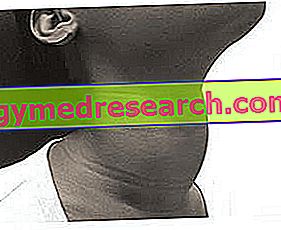Generality
The fibula is the even bone, which together with the tibia (with respect to which it is in the lateral position), constitutes the skeleton of each leg.

To simplify understanding, anatomy experts divide it into three portions: the proximal end (or proximal epiphysis), the body (or diaphysis) and the distal end (or distal epiphysis).
The proximal end is the portion closest to the femur (but with which it does not come into direct contact).
The body is the portion between the proximal epiphysis and the distal epiphysis; it has the task of housing different leg and foot muscles.
Finally, the distal end is the portion adjacent to the talus, one of the seven tarsal bones of the foot.
What is the fibula
The fibula is the even bone which, together with the tibia (equally equal), constitutes the skeleton of each leg .
In human anatomy, the leg is the region of the lower limb between the upper thigh, and the foot, below.
The fibula belongs to the category of long bones, such as the tibia and the femur. What makes it different from these two important bone elements is its particular slenderness: compared to the tibia and femur, in fact, it is much thinner.
POSITION COMPARED TO TIBIA
The fibula develops along the external side of the tibia. With reference to the sagittal plane, this means that the fibula is lateral to the tibia and the tibia is medial to the fibula.
An explanation of the concepts sagittal plane, lateral and medial is present in the box below.
Important note: meaning of medial and lateral

Figure: the plans with which the anatomists dissect the human body. In the image, in particular, the sagittal plane is highlighted.
Medial and lateral are two terms with the opposite meaning. However, to fully understand what they mean, it is necessary to take a step back and review the concept of the sagittal plan.
The sagittal plane, or median plane of symmetry, is the antero-posterior division of the body, a division from which two equal and symmetrical halves are derived: the right half and the left half. For example, from a sagittal plane of the head derive a half, which includes the right eye, the right ear, the right nasal nostril and so on, and a half, which includes the left eye, the left ear, the left nasal nostril etc.
Returning to the medial-lateral concepts, the word media indicates a relationship of proximity to the sagittal plane; while the word side indicates a relationship of distance from the sagittal plane.
All anatomical organs can be medial or lateral with respect to a reference point. A couple of examples clarify this statement:
First example. If the reference point is the eye, it is lateral to the nasal nostril of the same side, but medial to the ear.
Second example. If the reference point is the second toe, this element is lateral to the first toe (toe), but medial to all the others.
IN THE UPPER ARTS IT CORRESPONDS TO ...
In the upper limb, the bone corresponding to the fibula is the ulna . Along with the radius, the ulna constitutes the skeleton of the forearm. Like the fibula, radius and ulna are two equal bones.
Anatomy
Anatomy experts identify three main bone regions (or portions) in the fibula: the proximal end (also called the fibula's head), the body (or diaphysis) and the distal end (also called the peroneal malleolus).
Anatomical meaning of proximal and distal
Proximal and distal are two terms with opposite meaning.
Proximal means "closer to the center of the body" or "closer to the point of origin". Referring to the femur, for example, it indicates the portion of this bone closest to the trunk.
Distal, on the other hand, means "farther from the center of the body" or "farther from the point of origin". Referred (always to the femur), for example, it indicates the portion of this bone furthest from the trunk (and closer to the knee joint).
End? PROXIMAL OF PERONE
The proximal end of the fibula, or fibula's head, is the bone portion closest to the femur (hence to the thigh).
Similar to an irregular square, the head has some characteristics of absolute relevance:
- A flattened surface, in a medial position. This surface, called the facet, serves to articulate the fibula to the tibia, precisely to the lateral tibial condyle (NB: the lateral tibial condyle and the medial tibial condyle represent the main structures of the proximal end of the tibia).
Compared to the remaining bone structure, the orientation of the flattened surface is upward and forward,
- A rough ledge, in a medial position. This protrusion takes the specific name of apex or styloid process . The styloid process develops upwards and acts as a point of attachment for the terminal heads of the biceps femoris and the lateral (or peroneal) collateral ligament of the knee.
- A series of bone tubercles (ie prominences), located on the anterior and posterior surfaces. Anteriorly, there is a tubercle in which the initial head of the long peroneal muscle is inserted and a tubercle cha engaging one of the two ends of the anterior superior tibio-fibular ligament (the other end is joined to the tibia).
Later, there is only one tubercle, which binds to itself one of the two ends of the so-called superior posterior tibio-fibular ligament (also in this case, the other end is connected to the tibia).
The anterior and posterior superior tibio-fibular ligaments hold the fibula and tibia together.

PERONE BODY
The so-called body is the central section of the fibula, included between the proximal end (superiorly) and the distal end (inferiorly).
It has 4 edges (antero-lateral, antero-medial, postero-lateral and postero-medial) and 4 surfaces (the anterior, posterior, medial and lateral).
Starting from the description of the edges, the anterolateral border runs vertically, slightly below the head of the fibula and shortly before the lateral malleolus. Initially, it is in the front position; then, as it descends, it moves laterally. Its function is to form a separation septum between the extensor muscles of the fingers and the big toe and the long peroneal muscle.
The antero-medial border, or interosseous crest, develops mainly in the medial position and serves to hook the so-called tibial-fibular interosseous membrane . The tibio-fibular interosseous membrane is a thin sheet of fibrous tissue, interposed between the tibia and fibula, which separates the extensor muscles of the toes and the big toe from the long flexor muscle of the big toe.
The posterolateral border is a rather prominent ridge, which begins just below the styloid process and ends posterior to the lateral malleolus. During the downward path, it undergoes a slight lateral deviation. The function of the posterolateral border is to attach a fibrous band (aponeurosis), which separates the lateral surface, housing the initial ends of the long and short peroneal muscles, from the posterior surface, hosting the initial head of the long flexor muscle of the big toe.
Finally, the postero-medial border, or oblique line, starts from the medial side of the head and ends joining with the interosseous crest (antero-medial border). Its task is to hook a fibrous band (similar to the previous one), which separates the posterior tibial muscle from the soleus muscle and from the long flexor of the big toe.
Then passing to the description of the surfaces, the anterior surface is the area between the anterolateral border and the antero-medial border. Narrow and flat for the first third of the route, it becomes wider and grooved in the final part. It acts as a point of origin for three muscles: the extensor of the fingers, the long extensor of the big toe and the third peroneus.
The posterior surface is the space included between the postero-lateral border and the posterolateral border. It has a particular course: it is completely backwards, in the initial section; deviates in the medial direction, in the middle section; takes a position almost entirely medial, in the final section. Above, it contains the initial garments of the soleus muscle; in the middle it houses the nourishing hole (NB: see the chapter on the circulation of the fibula); finally, in the terminal tract it gives rise to the long flexor muscle of the big toe.
The medial surface is the area bounded by the anteromedial border and the posterolateral border. It acts as the point of origin of the posterior tibial muscle.
Finally, the lateral surface is the space between the anterolateral border and the posterolateral border. It is particularly large and equipped with deep grooves. For the first 2/3 of his journey, it runs in a completely lateral position; then, for the remaining one third of the journey, it tends to orient itself backwards. It is an insertion site for the long peroneal muscle and the short peroneal muscle.

Figure: edges and surfaces of the fibula.
End? DISTALE OF THE PERONE
The distal end of the fibula is the bone portion located closest to the bones of the foot (in particular the tarsus of the foot).
The first anatomical element characterizing this extremity is the so-called peroneal malleolus (or lateral malleolus ). The peroneal malleolus is a bone process that develops on the lateral margin of the fibula and contributes, together with the tibial (or medial) malleolus, to the stabilization of the astragalus (the main bone of the tarsus of the foot) inside a tibial cavity, located on the lower edge and called mortar .
Therefore, the second anatomical element characteristic of the distal end is the articular facet, which serves to join the fibula to the tibial bone. This facet occupies a medial position and is inserted into the so-called fibular incisura, a hollow of the tibia which is very similar to the base of a shower.

Figure: The nutritious vessels and the nourishing hole in the long bones.
JOINTS OF THE PERONY
The joints in which the fibula participates are:
- The superior tibio-fibular articulation (or proximal tibio-fibular ). It is the joint that joins the head of the fibula to the lateral condyle of the tibia. The aforementioned superior, anterior and posterior tibio-fibular ligaments provide stability to this joint element.
- The inferior tibio-fibular articulation (or distal tibio-fibular joint ). It is the joint that connects the distal end of the fibula with the fibular incision of the tibia. To reinforce the relationship between these two compartments are the anterior inferior tibio-fibular ligament and the posterior inferior tibio-fibular ligament.
- The ankle joint . Also known as the talocrural or tibio-tarsal articulation, the ankle is the articular element that derives from the insertion of the astragal (tarsal bone of the foot) inside the mortar (hollow located on the lower edge of the tibia).
- The fibrous joint (or syndesmosis ), formed by the interosseous membrane (between the medial margin of the fibula and the lateral margin of the tibia). Syndesmosis are joints where there is no direct contact between two bones; in fact, to hold the bone elements together, they are fabrics of a fibrous nature, such as the aforementioned interosseous membrane or a network of ligaments.
Another important fibrous articulation, very similar to that between fibula and tibia, is the syndesmosis located between ulna and radium, the two bones that form the forearm.
BLOOD SPRAYING
Internally, long bones, such as the fibula (but also the tibia, femur, etc.), have a very specific network of arteries and veins, which serves to guarantee them the right supply of oxygen and nutrients.
With the exception of its extremities - whose spraying is due to some branches of the anterior tibial artery - the fibula receives oxygen-rich blood from two derivations of the peroneal (or peroneal ) artery : the so-called nutritive artery and the periosteum arteries .
To make the oxygen-poor blood flow out of the fibula (NB: the extremities always represent an exception), are the nutritive vein - which closely accompanies the homonymous artery - and the periosteal veins .
The nutritive artery and the nutritive vein deserve a particular note, as they penetrate the body of the fibula, through a previously named structure: the nutritive hole (also known as nutritious canal).
PERONE FORMATION
Three ossification centers contribute to the formation of the fibula: one centered on the body, one on the proximal end and one on the distal end.
To start the ossification process is the center on the body of the tibia; to follow and in succession, the center of the distal end and the center of the proximal end enter into action.
Going into more detail:
- The ossification center of the body is activated around the 8th week of fetal life. Its activity causes the bone to develop towards the body and the ends.
- The ossification center of the distal end begins its activity around the second year of life. The bone portion it gives rise to meets the bony portion of the ossification center of the body at about the twelfth year of life.
- The ossification center of the proximal end is set in motion at about the 5th year of life. The resulting bone portion meets the bony portion of the body around the twenty-fifth year of life.
Functions
The fibula plays a fundamental role in the mechanism of locomotion.
In fact, it houses essential muscles for walking, running and jumping and contributes to the formation of the ankle, the joint that allows plantarflexion and dorsiflexion movements of the foot.
For those who are not aware of it, plantarflexion is the movement that allows you to point your foot towards the floor. The human being performs a plantarflexion movement when he tries to walk on his toes. Dorsiflexion, on the other hand, is the movement that allows you to lift your foot and walk on your heels.
| List of the 9 muscle elements that originate and end at the tibia. | ||
Muscle | Head end or initial leader | Contact site on the tibia |
| Hamstring muscle | Head end | Head of the fibula |
| Long extensor muscle of the big toe | Initial leader | Medial margin of the fibula |
| Extensor muscle along the toes | Initial leader | Proximal section of the medial margin of the fibula |
| Peroneal muscle third | Initial leader | Distal section of the medial margin of the fibula |
| Long peroneal muscle | Initial leader | Head and lateral margin of the fibula |
| Short peroneal muscle | Initial leader | 2/3 proximal to the lateral border of the fibula |
| Soleus muscle | Initial leader | 1/3 proximal to the posterior margin of the fibula |
| Posterior tibial muscle | Initial leader | Lateral section of the posterior margin of the fibula |
| Long flexor muscle of the big toe | Initial leader | Posterior margin of the fibula |
DIFFERENCES FROM FEMORE AND TIBIA
The femur and the tibia of each lower limb are bones with a double function: they guarantee locomotion, housing different muscles and composing joints, and support the weight of the body, distributing it along the entire lower limb.
As we have just read, the fibula covers only the first of these two functions. Moreover, it cannot fulfill the second, as it is connected to the tibia and not to the femur, which is the first structure of the lower limb to undergo the weight of the body.
Perone diseases
The fibula can fracture, like all other bones in the human body.
The fibular fractures are usually the result of traumas to the leg and involve, with a particular frequency, individuals with reduced bone mass and subjects who practice contact sports, such as football, rugby, American football, l ice hockey etc.
There are various types of fibular fractures, including:
- Fracture of the head of the fibula . The fractures of the head of the fibula are very often the consequence of a sudden and abrupt contraction of the biceps femoris muscle, whose terminal head is inserted right into the proximal end of the fibula.
The fractures that arise due to a muscular contraction take the specific name of avulsion fractures .
Most young athletes suffer from it, due to a not yet consolidated bone mass.
- Fracture of the peroneal malleolus . Generally due to a marked movement of the foot eversion, this type of injury is very often associated with the fracture of the tibial malleolus (or medial malleolus). The cause of bone rupture is the strong and abnormal pressure exerted by the talus as a result of an unnatural movement of the ankle.
The double fracture of the malleoli is a clinical condition that the doctors indicate with the term of Pott's bimalleolar fracture.
- The tibia and fibula fracture . It is a condition with long healing times, which requires a period of immobilization and sometimes even an ad hoc surgery.
The double fracture of the leg bones mainly concerns subjects who practice contact sports and people involved in serious road accidents.
According to an interesting medical statistic, 75-85% of fibular fractures are also accompanied by fractures of the tibia.



